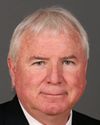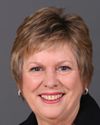Thank you, sir, and thank you for the introduction.
Before I give you my introductory remarks, you indicated who the team is. I in fact am not from Veterans Affairs, and I don't work for either department. I'm the volunteer chair. I wish I were from Veterans Affairs, with their wage scale.
The two co-managers on either side of me are from DND and VAC. We have two peer support coordinators. I'll come back to them in a minute. They're the “coal face” people, as we call them, who deal with the peers.
There are some members of this team who have been involved with the operational stress injury social support program from the beginning, and one of us, I believe, will be able to answer any questions you may have once I'm finished this presentation.
I understand you've been given a printed version of the slides. I will not read all of the slides. Rather, I will hit a few of the high points and focus on what's new with the operational stress injury social support program, the key determinants to its success, and the major challenges that face the organization.
I am sure that most of you are familiar with the term “operational stress injury”, or OSI. As you know, OSI is not a diagnostic term but rather a term developed by the OSI social support organization here in Canada to put the focus on the injury and to work toward de-stigmatization of the condition. The term is now in use by most clinicians as a way to encompass all operationally related mental health issues. This includes some elements of the U.S. military.
The presentation package contains some background on the joint DND and Veterans Affairs Canada OSI advisory committee, which I chair. This group, formed in 2002, brings together a group of interested people from Natinal Defence, Veterans Affairs, veterans organizations, the RCMP, and various mental health professions three times a year to provide advice to the two co-managers, Kathy Darte and Major Mariane Le Beau, and feedback from me to the senior management in both sponsoring departments--namely, the chief of military personnel, Major-General Walt Semianiw, and the assistant deputy minister of veterans services, Brian Ferguson.
OSISS itself came into being within DND in the spring of 2001 in response to input from SCONDVA, the Croatia board of inquiry, and the DND Canadian Forces ombudsman's office. Shortly thereafter, recognizing the shared responsibility for the welfare of CF members and veterans and their families, a partnership was formed with Veterans Affairs Canada.
OSISS was clearly the result of the vision and drive of one officer--similar to Major Le Beau--by the name of Lieutenant-Colonel Stéphane Grenier, the founder. He has recently returned from a tour in Afghanistan, and is now the OSI special adviser to the chief of military personnel. He and General Couture, then ADM of human resources in DND, and ADM Brian Ferguson are the ones who kicked this off. But as I say, Stéphane Grenier is the founder, and he is dedicated toward this OSISS program.
His VAC partner in that early work, Ms. Kathy Darte, is here today. She continues her great work alongside Mariane Le Beau from DND.
The mission of OSISS is twofold: to develop social support programs for members, veterans, and their families who have been affected by operational stress; and to provide the education and training that will eventually change the culture toward psychological injuries in the CF.
The key to effective peer support--the heart of the OSISS program--is the initial selection of the right kinds of people. For example, I direct your attention to slide three, and to the peer support coordinators who are here today. Shawn Hearn is the peer support coordinator in Newfoundland and Labrador. Cyndi Greene, although she's a Newfoundlander, is the peer support coordinator in Calgary and southern Alberta.
Both of the aforementioned, like all of the peer support coordinators serving military members and veterans, have suffered from an OSI. They are now at a point in their recovery where they can help others like them, which is the basic ingredient of peer support.
Aside from the basic two-week training program they all receive, the OSISS program runs a far-reaching continuous education phase, including self-care for peer support coordinators and the family of peer support coordinators. In the end, it all comes down to developing trust with the members and the veterans and the families who come forward, allowing them to proceed at their own pace and providing a support shoulder to lean on. As Shawn has indicated to many of his peers throughout the years, it is a beacon of hope.
It is essential that the peer support workers understand the role they play: encourage to seek treatment, acknowledge the problem or problems, facilitate referral to a professional resource, and assist with access. The danger for the peer support coordinator is burnout, compassionate stress, trauma, depression, and physical illness. What is absolutely amazing and an attestation to the quality of the people involved, selected by the co-managers left and right, is that the level of care provided by both departments in this program is such that there have been very few problems with the peer support coordinators in the years this program has been running.
There are several new initiatives to talk about in OSISS, which you are welcome to pursue in a question period. They include the bereavement peer support initiative, which delivers support to the immediate families of those who have lost a loved one in military service, again to be delivered by those who have been through a similar event. Though not technically part of the OSISS mandate, it's being done anyhow under the leadership of the managers left and right.
There has been considerable international interest in the success of this program. Ms. Kathy Darte and Major Le Beau can talk to some of these approaches at more length during the Q and A.
The third-location decompression operations in Cyprus provide members rotating out of Afghanistan an opportunity to spend a few days transitioning from the theatre of war to their living rooms and bedrooms, all part of a significantly enhanced redeployment program. Shawn Hearn and Cyndi Greene, the two PSCs we have with us, have both spent time with the troops in Cyprus and can speak on that during the question period.
We have learned that there are several key determinants to success in a program like this. The first and most important is the need to involve peers such as Greene and Hearn right from the beginning in the program development and policy. An excellent interdepartmental partnership is essential, as is the use of a multidisciplinary management team. This OSISS program is a sterling example of excellent cooperation between DND and Veterans Affairs Canada.
The emphasis on self-care and realistic boundaries has been another key area. As I mentioned at the beginning, it is essential to recruit and screen the right people, and this is perhaps the area in which this program has excelled, at least in my opinion. To provide relief for that key group of peer support personnel, it is vital to recruit, train, and retain a network of volunteers. I am sure Cyndi and Shawn will want to talk about volunteers; while they're here, their volunteers are covering the bases with the peers they have on file.
In terms of challenges, there are certainly some out there. For example, there are a number of systemic barriers in place. Some clinicians are still suspicious of those who are not mental health professionals meddling in their business. On the other hand, others who have experienced the value of working with peer support coordinators literally sing their praises.
Just the physical size of the territory covered by this very small group of peer and family peer support coordinators is amazing. We recognize that many soldiers are off in the rural areas where they just literally cannot be reached. Especially for reservists who may live far away from a major base, getting to where we have a peer support coordinator or getting the PSC to the soldier can be a very real challenge. Our two PSCs today can address that challenge in a few moments.
Growing that volunteer network I referred to earlier is another challenge the PSCs face each day. Once the investment has been made to find and train these folks, retaining them becomes another challenge. The peer support groups that are such an important part of this program also take a lot of effort, time, and coordination. Because many peers are reluctant to use on-base facilities, even finding a place to meet can be problematic.
The last challenge on this list is certainly not the least. Let there be no doubt that the culture of the Canadian Forces in dealing with mental health issues has been changing, albeit slowly. However, there's still a long haul ahead. Education and training are key to culture change, and as is often the case, the longer-term investments are frequently overtaken by the shorter-term demands. To even sustain the gains made in the last few years, great effort is required. This is and will remain a significant challenge.
Before I finish I would like Shawn Hearn and Cyndi Greene to give you a two-minute briefing on their activities.
Shawn.




